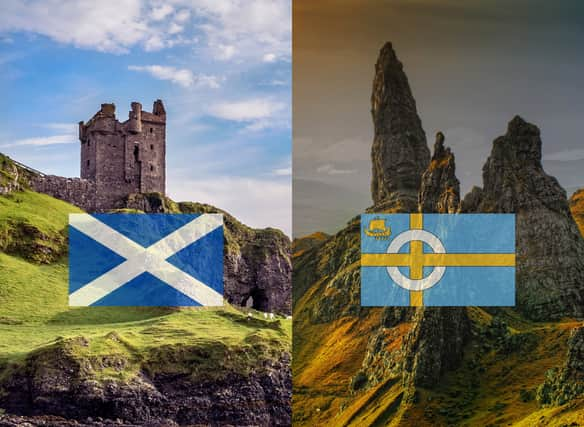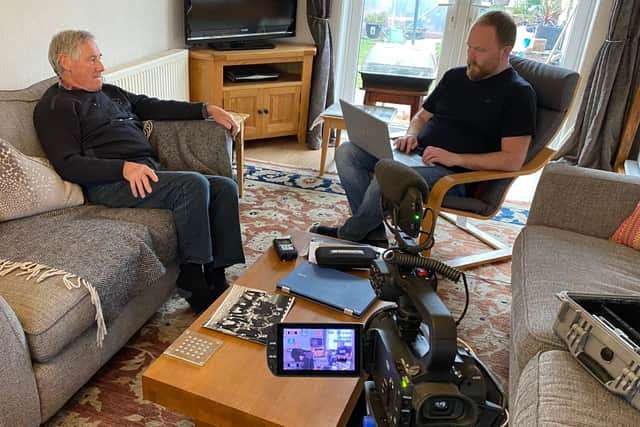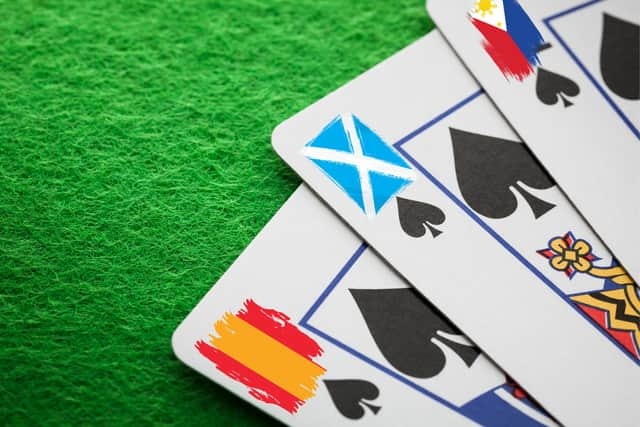Why Scottish Dialects Matter: Dòrlach leads the charge in keeping Scotland’s lingual heritage alive
This article contains affiliate links. We may earn a small commission on items purchased through this article, but that does not affect our editorial judgement.


Scotland is famous for its unique linguistic landscape. A variety of heritage languages have influenced the country over the years and this is evidenced by our distinctive place names - often mispronounced - that hold echoes of our chequered past e.g., Old Norse motifs are abundant in regions like Orkney that were settled by Norsemen centuries ago.
English may be the most spoken language today but the Scottish spirit is an enduring one and has yet to fully yield the cultural space to this anglocentric phenomenon. From cities in the central belt like Edinburgh to islands of the hebrides such as Skye, words and sayings that you won’t hear anywhere else still thrive in Scotland.
Advertisement
Hide AdAdvertisement
Hide AdMany are tied to the Scots language, a germanic tongue closely associated with the famous bard Robert Burns which has colourful dialects including Doric in the northeast. The Scottish consciousness runs deeper, however, as our nation’s rich history and vibrant culture has been shaped by Gaelic; the Celtic inheritance that Visit Scotland describes as our “founding language”.
Many observers remark that Gàidhlig is experiencing ‘new levels of popularity’ as it enjoys a ‘renaissance’ in pop culture and beyond. The TV smash hit ‘Outlander’ (adapted from the novels by Diana Gabaldon) has been commended for its inclusion of Gaelic terms throughout the series.
Duolingo, the world’s most-downloaded education app, announced last year that over 1.5 million learners had signed on to study Gaelic since the course was released three years prior. Plus, with the introduction of bilingual road signs and an exclusive Gaelic TV station, it is easy to presume that the health of the language is in a good place but sadly it is not.
The Highlands and Islands, for example, are said to be the ‘strongholds’ of Gaelic. Yet, in areas like Stornoway in the Outer Hebrides (which recently opened a ‘Gaelic Cafe’) researchers claim that only a slight majority of locals spoke the language with public conversations featuring it a mere 9% of the time. Not only has Gaelic become minoritised in its own heartlands, but its dialects that are scattered across the nation have become even more so endangered with some already extinct like that of St Kilda’s.
These varieties belong to many regions and pack a wealth of culture unique to the forebears of such areas that spoke them. Thus, if lost, their distinct identity and insights are lost too and the aforementioned ‘renaissance’ shows no sign of counteracting this dialectal decline. Fortunately, help is at hand to bring back from the brink these dialects that are withering away in modern Scotland.
Dòrlach is a charity that is “researching and recording the minority Gaelic dialects of Scotland, and encouraging, enabling and promoting their active use” according to OSCR. Àdhamh Ó Broin, previously described as the “world’s most sought-after Gaelic Consultant” and well-known for coaching the actors of Outlander in Gaelic, is the organisation’s founder.
Here is an overview of the importance of native languages and dialects and the work being done by Dòrlach to not only conserve this linguistic heritage in Scotland but restore it to its former prominence.


What is Dòrlach?
Dòrlach is a charity that was registered in 2020, their first ‘operational objective’ states: “To promote the cause of Scotland’s Gaelic dialects, especially those in a perilous condition in terms of paucity of speakership.”
Advertisement
Hide AdAdvertisement
Hide AdIn summary, the Scottish Charity Regulator explains that their mission is to “advance education, heritage and culture” by “researching and recording the minority Gaelic dialects of Scotland, and encouraging, enabling and promoting their active use as living community vernaculars”. Furthermore, “organising cultural and linguistic exchanges between speakers of Scottish Gaelic and speakers of other Goidelic, Celtic and minority languages around the world.”
The founder, Àdhamh Ó Broin, acts as a Convenor and Fieldworker for the organisation. According to his ‘Mini Bio’ on IMDb, he “is a Gael of mixed Irish and Highland Caithness descent, multi-instrumentalist musician, writer and Gaelic language activist who belongs to Cowal in Argyll, Scotland.
“Àdhamh is the first person to raise a family of native speakers of his home dialect in 80 years and the first ever to resurrect a moribund Scottish dialect word for word to the status of a living language.”
In his words: “My children all speak it fluently and consider it their first and main language - in a way they are guardians of the Dalriada dialect.”
Ó Broin is widely known for serving as a Gaelic Consultant for Sony Pictures’ ‘Outlander’ (2014 - 2023) and has since continued such work in a number of short films highlighting Gaelic language and culture. On their social media, we see the Dòrlach team traversing the many gorgeous and overlooked vistas of Scotland that are home to the native peoples that keep Gaelic (along with its vibrant dialects) alive in their homes.
Aside from documenting the language and centering themselves on its preservation, Dòrlach reminds these Gaelic speakers - who have become isolated in their local areas - that they are important, not forgotten and valued members of the community.
Meaning of “Dòrlach” in Gaelic
According to the Learn Gaelic Dictionary the word “dòrlach” refers to a ‘handful’ or ‘batch’. If phrased like “dòrlach math” (‘math’ being the adjective for ‘good’) it means ‘a good deal’.
If we refer to the Dictionaries of the Scots Language, the term ‘dorlach’ denotes a ‘quiver of arrows’. The bow and arrow imagery is reminiscent of Fingal who the British Library explains “was the leader of the Scottish Gaels” and in mythology his arrow was said to split the ‘praying rock’ which can be seen today in Glen Lyon.
Advertisement
Hide AdAdvertisement
Hide AdOn their social media, they go by “Dòrlach Alba”. ‘Alba’ (pronounced “Al-a-buh”) is the Gaelic word for Scotland.


What is the difference between languages and dialects?
Pick a card, any card, and imagine it represents a native language. Every standard deck has unique ‘face cards’ and of that group you find variants of each that come under an array of different suits. They may all be of the same deck and somewhat resemble one another but they’re distinctive too.
In this analogy the ‘Jester’ can be thought of as ‘Emoji’ as some described it as a ‘new universal language’ or ‘digital lingua franca’ (not an official language.)
Seen above, we have cards that represent the Spanish, Scottish Gaelic and Filipino decks. Alta Lingua tells us that dialects spoken in Spain include “Aragonese, Leonese, Asturian, Andalusian, Canarian” among others. The Center for Applied Linguistics explains that Tagalog (the main native language of the Philippines) has eight major dialects.
Meanwhile, Gaelic has numerous dialects that originate from Arran, Southwestern Mull, Duirinish in Wester Ross and many other Scottish regions (to name a few) as Omniglot explains.
When learning a new language you have likely met a native speaker at some point that shook your confidence in the progress you’d made. What is this vocabulary they’re using? Why is their pronunciation so different? Are we speaking the same language? Congratulations! You’ve reached the next stage of your language journey; dialectal exposure.
Rosetta Stone summarises that “a dialect is a variety of a single language that sounds different but shares enough of the same characteristics that it can be easily understood (by native speakers, at least).”
Why do native languages (and dialects) matter?
February 21 is International Mother Language Day. UNESCO proclaimed it as such in 1999 in the interests of promoting linguistic diversity worldwide. As more people embraced multilingualism and travelled across the globe, research revealed that their children often lost their native language proficiency as the environment they grew up in required linguistic assimilation and thus use of their mother tongue was not endorsed.
Advertisement
Hide AdAdvertisement
Hide AdAlthough many Scots may live in the same heartlands that their Gaelic-speaking forebears did, a similar phenomenon occurred here where the push for English-speaking societies was so powerful that their native Celtic tongue was both discouraged and - regrettably - stigmatised as well.
An article entitled ‘Three reasons you should love your native language’ written by Jenie Gabriel - originally from the Philippines - published by translation company Gengo notes that “preserving your native linguistic proficiency matters because of many personal, social, intellectual, educational and economic reasons.”
So, what about dialects? As explained, they are very specific to the regions they originate from and so a huge amount of niche culture is maintained within them in a way one standardised language isn’t.
The Anthropology Review explains: “Dialects matter because they are an essential part of linguistic diversity.
“They reflect the unique histories, cultures, and identities of different communities around the world.
“Without dialects, language would be homogenised and lose its richness and complexity.”
Where is Scottish Gaelic spoken?
According to the Scottish Government: “Gaelic speakers are spread throughout Scotland.
“Of those who identified themselves as Gaelic speakers in the 2011 Census the council areas with the highest proportions able to speak Gaelic were found to be in Na h-Eileanan Siar (52%), Highland (5%) and Argyll & Bute (4%).
Advertisement
Hide AdAdvertisement
Hide Ad“There is also a high degree of urbanisation within the Gaelic speaking community with large numbers of Gaelic speakers living in Aberdeen, Edinburgh, Greater Glasgow and Inverness.”
The University of Aberdeen adds: “Emigration from the Gaidhealtachd (Highlands and Islands) has been commonplace since the eighteenth century, when Gaelic-speaking communities were established in the urban towns and cities of Glasgow, Greenock, Paisley, Edinburgh, Dundee and Perth.”
They continue: “The number of emigrants in the eighteenth and early nineteenth centuries were so large that Gaelic communities were also established in other countries.
“The largest and most well-known of these was in Canada.
“There is still a notable Gaelic presence in Canada, most especially in Nova Scotia, where there is still a small community of native speakers and a larger group of people who are learning the language.”
How can we support Dòrlach?
Dòrlach is on a mission to restore Gaelic dialects to the status of ‘living community vernaculars’. Such an endeavour in the height of an English-speaking Scotland is no small feat and the work they do is only priceless in the sentimental sense. For anyone who wishes to donate to this cause which is championing Gaelic revitalisation this can be done via their website.
If you would like to learn more about this Celtic heritage, including reasons to learn Scottish Gaelic, we recommend following Dòrlach on social media to keep up to date with their mission and what it means to Gaelic communities and other minority language groups. Or, if inspired, you can always “dae it yersel” (the Scots phrase for ‘do it yourself’).
As Rosetta Stone puts it: “Dialects also allow you to build deeper connections.
“Think of the way a stranger’s eyes light up when you reveal that you share something in common.
Advertisement
Hide AdAdvertisement
Hide Ad“A shared language between two strangers can invoke that same joy, and the knowledge of a regional dialect can enhance that tenfold.”
Whether you speak or study Gaelic there is no harm in learning a dialect as you do and the rewards are untold. An old Gaelic proverb says: “Cha bhi fios aire math an tobair gus an tràigh e” which means “the value of the well is not known until it goes dry.”
So, let’s focus on the ‘wellness’ of our native mother tongues and appreciate their remarkable diversity.
Comments
Want to join the conversation? Please or to comment on this article.
